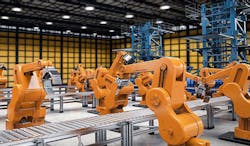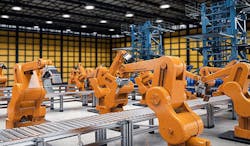Reliable Connectors Keep Industrial Robotics Moving Efficiently (.PDF Download)
Industrial robotics have been on the horizon for over a half a century, but now more than ever they’re transforming the industrial workplace. The industrial robot of today brings productivity, cost efficiency, and greater safety to their repetitive assigned tasks (Fig. 1). And behind the scenes of every effective and reliable robot is a myriad of scalable and flexible connectors to support these redundant, automatic, and/or remote robot activities.
1. Stationary manufacturing robots require reliable, time-lasting connectors as they perform repetitive actions.
Common industrial mobile robotic technologies for detecting objects and obstacles include radar, cameras, optical, and ultrasonic. Radar, optical, and ultrasonic sensing transmit high-frequency waves into the atmosphere and around the circuits. Light and ultrasonic waves listen or watch for the echoes that reflect back from any obstacles. Radar sensors employ antennas to find reflected radio-frequency waves. Optical time-of-flight (ToF) sensors use a photodiode to capture reflected light waves from obstacles. So, it’s not surprising that as robotic technologies advance, so do complementary connector technologies.
This evolution of industrial robotics offers greater flexibility, range of motion, speed, functionality, and precision. For robots to operate in these complex ways, they must be able to collect and process a great deal of sensing data in hostile electrical and physical industrial environments. The task ahead is to identify and use highly reliable connectors for this industrial challenge. This article identifies a list of appropriate connectors to solve these problems

